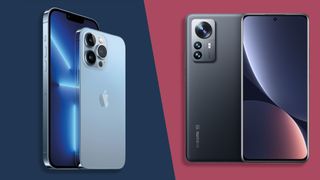
The Xiaomi 12 Pro is a brand-new contender at the very top of the smartphone food chain. And make no mistake, it’s worthy of taking on flagship royalty, including the iPhone 13 Pro.
Having spent much of the past year scrapping with Apple over the number two smartphone maker spot, Xiaomi seems ready to step up the fight in 2022.
So how do the two high-end handsets compare? Which classy smartphone is worth four figures? Let’s take a closer look and find out.
iPhone 13 Pro vs Xiaomi 12 Pro price and availability
The Xiaomi 12 Pro goes on sale on 15 April, 2022. Prices start at $999 for 8GB of RAM and 128GB of storage, although note that this phone isn’t actually shipping in the US. In the UK, there will be just the one model available, with 12GB of RAM and 256GB of internal storage for £1,049 (around £1,385).
The iPhone 13 Pro arrived on September 24, 2021, with prices starting at $999 / £949 / AU$1,699 for 128GB, $1,099 / £1,049 / AU$1,869 for 256GB, and $1,299 / £1,249 / AU$2,219 for 512GB. There’s also a 1TB model for $1,499 / £1,449 / AU$2,569.
These two phones are very similarly priced, then. However, the iPhone 13 Pro wins on pure availability and pricing options.
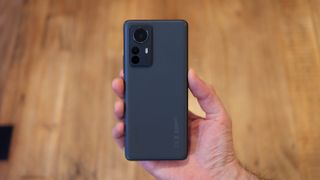
Design
They might be priced similarly, but physically, the Xiaomi 12 Pro is the bigger phone.
At 163.6 x 74.6 x 8.2mm, it dwarfs the iPhone 13 Pro, which measures just 146.7 x 71.5 x 7.65mm. Interestingly, though, the two phones share an identical weight of 204g.
The reason for this can likely be attributed to the iPhone 13 Pro’s use of more premium materials, at least when it comes to the stainless steel chassis. Xiaomi uses lower-grade aluminum.
Weight aside, there’s precious little common ground over the designs of these two phones. The iPhone 13 Pro is a boxy, square-sided device, while the Xiaomi 12 Pro sports curves on both the front and back edges.
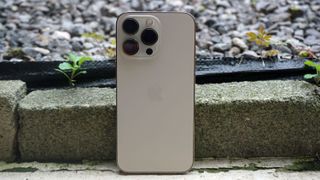
We’re big fans of the silken, velvety finish of the Xiaomi 12 Pro’s rear surface. There’s a frosted, speckled glint to even the Gray model (it’s also available in Purple and Blue), whereas the iPhone 13 Pro opts for a plain, smooth finish (in a greater choice of Graphite, Gold, Silver, Sierra Blue, and Alpine Green).
Both phones resist fingerprints remarkably well, and both are decidedly grown-up looking in their own distinct ways.
One area in which the iPhone 13 Pro takes a clear win is for water- and dust-resistance. While the iPhone 13 Pro is IP68-certified, the Xiaomi 12 Pro lacks an IP rating, which is almost unforgivable in such a premium smartphone.
The two handsets take very different approaches to biometric authentication. The iPhone 13 Pro has that slightly unsightly Face ID notch that enables facial recognition. The Xiaomi has a speedy under-display fingerprint sensor and a more subtle punch-hole cut-out.
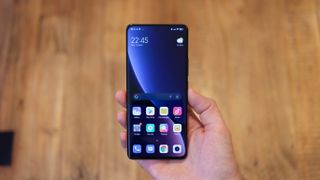
Display
The crucial point in being bigger is that the Xiaomi 12 Pro has a significantly larger display than the iPhone 13 Pro. The Xiaomi is 6.73-inches, while the iPhone 13 Pro is a relatively small 6.1-inches.
Both are LTPO AMOLED displays with 120Hz refresh rates, although while the iPhone can drop to 10Hz depending on the task, the Xiaomi can dip right down to 1Hz. Not that this makes much of a difference when it comes to battery performance, as we’ll go on to discuss.
Xiaomi’s screen really is a treat, going right up to a peak brightness of 1500 nits in sunny conditions. The iPhone 13 Pro’s display hits a lesser 1200 nits.
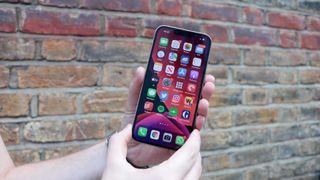
The Xiaomi 12 Pro’s screen is sharper, too, to the tune of 3200 x 1440. Apple’s flagship can only get to 2532 x 1170, although in practical terms, we defy anyone to spot the difference – especially with that difference in size.
In addition, the iPhone 13 Pro’s display wins out for flatness. The Xiaomi 12 Pro screen curves off at the edges, which can lead to the odd false input, and also creates an imperfect canvas when watching full-screen landscape content.
All in all, though, the Xiaomi 12 Pro’s screen is simply bigger, brighter, and sharper than that of the iPhone 13 Pro.
Camera
The one thing these two camera systems have in common is their unusual balance. The iPhone 13 Pro has a triple 12-megapixel setup, while the Xiaomi 12 Pro has a triple 50-megapixel setup.
That’s quite unusual, even among flagship phones, where one or both of the telephoto and ultra-wide sensors are typically of a different resolution to the main sensor.
The Xiaomi 12 Pro is the first phone to use the 1/1.28" Sony IMX707 sensor for its wide camera, which captures 1.22µm pixels and 2.44um fusion pixels (Xiaomi’s term for pixel binning). It has an f/1.9 aperture, and is backed by OIS.

The iPhone 13 Pro’s main sensor is smaller at 1/1.65", but it’s still the largest yet in an iPhone. It also captures larger 1.9µm pixels without the need for pixel binning, and is accompanied by a wider f/1.5 aperture. Apple’s phone has a more advanced 5-axis stabilization system, which keeps night shots and videos supernaturally steady.
Another way in which the iPhone 13 Pro camera pips the Xiaomi 12 Pro is with its 3x optical zoom, which gets closer to the action than the 2x Xiaomi equivalent. Apple’s ultra-wide can also capture macro shots, while the Xiaomi’s lacks autofocus.
Hardware aside, the main difference here relates to color science. Apple’s algorithms lead to famously balanced, natural-looking shots, while Xiaomi goes for a punchier and more vibrant look.
Apple’s ace card here is its A15 Bionic chip, which drives enhancements such as Smart HDR 4 and Photographic Styles, the latter of which lets you change the complexion of your shots.

On the video front, the iPhone continues to rule supreme. This time you get support for the advanced ProRes codec, which packs in way more information for richer footage. Cinematic mode lets you change the point of focus post-production, and will even automatically adjust the focus according between subjects.
The Xiaomi 12 Pro, for its part, can manage 8K video at 24fps. The iPhone can only manage 4K at 60fps, although we still think 8K video is a feature with extremely limited appeal.
In our review, we said that Xiaomi 12 Pro’s main camera “produces slightly sharper photos than a top-tier iPhone”, although we’d still give the iPhone 13 Pro’s camera the overall win for its balance and flexibility.
Specs and features
The Xiaomi 12 Pro runs on the Snapdragon 8 Gen 1 (4nm), just like most other 2022 Android flagships. It’s fast, but the iPhone 13 Pro’s A15 Bionic is faster.
In CPU benchmark terms, the A15 Bionic blitzes its Android opponent, although to the Snapdragon 8 Gen 1’s credit, it does manage to claw back a couple of rounds in the GPU stakes.
For day-to-day use, you won’t notice these differences. These are simply two of the fastest phones that money can buy, and no app or game will make either phone blink.
In terms of memory, the Xiaomi 12 Pro gets 12GB while the iPhone 13 Pro goes with 6GB. However, owing to the different ways in which iOS and Android handle memory, there’s no advantage that can be drawn from that in either direction.
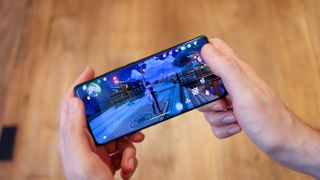
When it comes to storage, Xiaomi supplies either 128GB or 256GB of internal storage, depending on the region. Apple, meanwhile, offers a choice of 128GB, 256GB, 512GB, or 1TB of storage, wherever in the world you are.
Xiaomi has packed its phone with quad speakers sporting Harman Kardon tuning and support for Dolby Atmos, and they sound suitably expansive and loud. However, our reviewer found that it still “falls behind the iPhone 13 Pro… when it comes to rounded audio and depth in the bass notes”.
Picking between iOS and Android is typically a matter of preference. However, we’re talking about exactly the same iOS as always, which is precisely as Apple intended it. With the Xiaomi 12 Pro, it’s Xiaomi’s custom take on Android, called MIUI.
MIUI 13 is reasonably fluid, but it’s rather cluttered, packs a little too much bloatware, and it doesn’t take advantage of Android 12’s smart ‘Material You’ home screen customization system.
Battery
The Xiaomi 12 Pro comes packing a 4600mAh battery, which is much larger than the iPhone 13 Pro’s 3095mAh cell. However, it isn’t huge in Android terms, with Google’s OS typically using more system resources.
We described the iPhone 13 Pro as having “remarkably better battery life than we’ve seen on the iPhone 12 Pro and other Pro handsets before it”, which equates to it being “capable of lasting a full day of normal usage”.
As for the Xiaomi 12 Pro, we found that it “easily got us from morning to night… though it definitely isn’t a two-day smartphone.”
There isn’t a great deal of difference when it comes to stamina, it seems.

However, Xiaomi blitzes Apple when it comes to recharging. It doesn’t just support 120W fast-charging, it bundles the necessary charger in the box, to get you from 0 to 100% in just 20 minutes or so. That’s the fastest charging of any widely available smartphone here in the West.
The iPhone 13 Pro, by contrast, only supports 20W wired charging, and you’ll have to supply that charging brick yourself.
Both phones support wireless charging, but while the Xiaomi extends to an impressive 50W, the iPhone 13 Pro only offers 15W (with the appropriate MagSafe charger).
Takeaway
We found the Xiaomi 12 Pro to be “one of the most balanced phones around”, while the iPhone 13 Pro is “one of 2021’s best smartphones”, managing to retain that status into early 2022.
We scored the Xiaomi 12 Pro a tad higher in our review, but the two phones are sufficiently different that it’s tricky to call an outright winner.
The Xiaomi wins in terms of its larger, sharper and brighter display, and its phenomenally fast and generous charging provision. The iPhone, on the other hand, pulls ahead with its more flexible and sophisticated camera system, and its more robust IP68 certification.
If these categories don’t decide it for you either way, then it will likely come down to those age-old design and OS preferences. Either way, we don’t think you’ll be disappointed with your choice.
- Check out our full list of the best smartphones
Get daily insight, inspiration and deals in your inbox
Get the hottest deals available in your inbox plus news, reviews, opinion, analysis and more from the TechRadar team.
